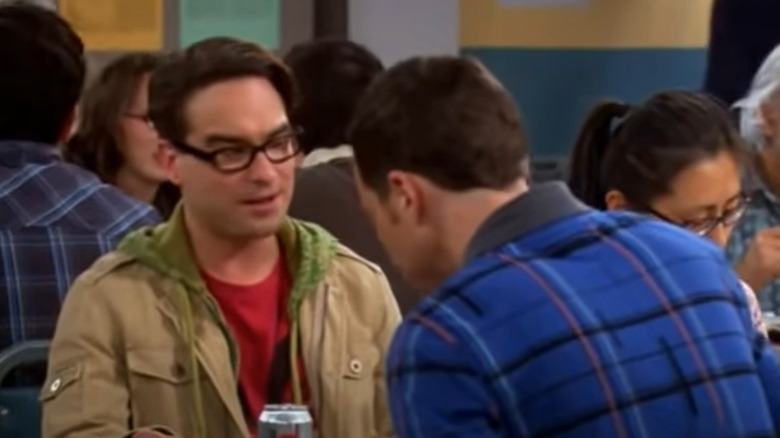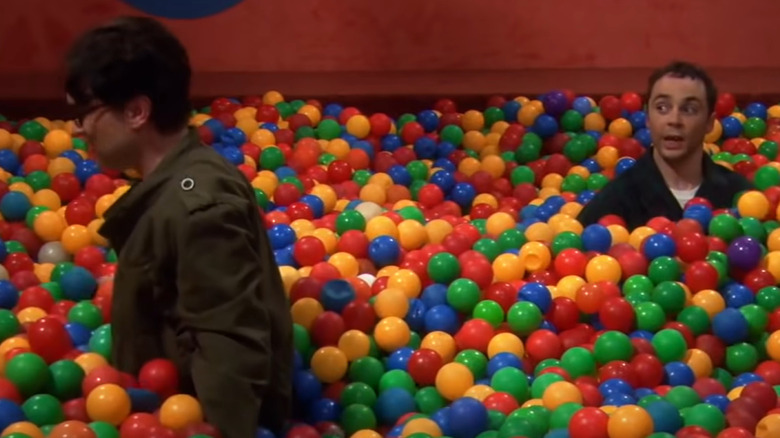The Big Bang Theory Fans Actually Walked Away With This Cool Piece Of Knowledge
Early episodes of "The Big Bang Theory" first generate laughs from the culture clash of awkward nerdy scientists Sheldon (Jim Parsons) and Leonard (Johnny Galecki) and their neighbor, the gorgeous, outgoing actress Penny (Kaley Cuoco). This means that a ton of references to cult movies, television, and scientific experiments, from "Doctor Who" to "Star Trek," have been name-dropped over the course of the hit sitcom's 12 seasons, even in the title of the show.
According to Wired, the show's writers actually consulted David Saltzberg, a real physics and astronomy professor, in order to get the math or terms right whenever the characters conducted experiments. Of course, another notable scientist was almost always in relative proximity to the show's production as well. Many fans probably know that Mayim Bialik, the actress who played Amy Farrah Fowler, also has a P.h.D. in neuroscience and aided Saltzberg with making sure all of the biological facts were correct too (via National Center for Women & Information Technology).
This means fans can learn a lot from watching the show, even in passing, because of the writing's accuracy. That scientific knowledge includes a famous, if also morbid, theory that illustrates a key principle of quantum mechanics.
Redditors liked Schrodinger's Cat from the first season finale
Named for Erwin Schrödinger, the quantum physicist who created the theory, Schrödinger's Cat is a thought experiment where (theoretically) a cat is placed inside a box along with poison and some radioactive material. If any of the radiation decays, this triggers the poison, killing the cat. But if the material doesn't do anything, the cat, as unseen by the observer, is in a state of both life and death (via Discover Magazine).
When u/Aggressive-Nobody473 asked other "Big Bang Theory" fans about what they learned from the show, several commenters mentioned Schrödinger's Cat as a favorite. The theory is first explained in Season 1, Episode 17 ("The Tangerine Factor") as Sheldon uses it to explain the possibilities for Leonard and Penny's blossoming relationship.
In one comment, u/FruitySwiftA113 wrote, "I use it in every day [sic] conversation and comparisons now." Other Reddit users appreciated the real-life science reference, but also ultimately remained reticent to use it in everyday life. For example, u/Rosemoorstreet shared that they loved it, but wrote, "the science is so far over my head that there is no hope for me to learn any of that!" Still, the concept is so compelling that it is hard not to think over it, even if one part sounds particularly creepy.
Sheldon illustrates physics with a ball pit
Throughout its run on CBS, "The Big Bang Theory" was actually quite competent at illustrating complex scientific problems and ideas within sitcom jokes and real-life examples. It also accurately showed how scientists work through certain issues. Take, for instance, Sheldon's frustration over a serious physics problem in Season 3, Episode 14 ("The Einstein Approximation").
In his attempt to understand why electrons travel through the substance graphene without mass, Sheldon pulls several all-nighters. Most crucially, the anti-social scientist uses multiple tools, including lunch food and the contents of a ball pit, to try and represent electrons in transit. However, it's only when he doesn't actively try to think about the issue that he's able to solve it.
Sheldon may lose his marbles while trying to illustrate this process with actual marbles, but these kinds of physical demonstrations are pretty common when scientists are working on theories. According to Science Learning Hub, creating a model, whether in physical form or on a computer, can be crucial in illustrating new hypotheses, or providing a way of explaining complex ideas and data. Most scientists just have the common sense to get a good night's rest and not go as far as Sheldon is often prone to do.


